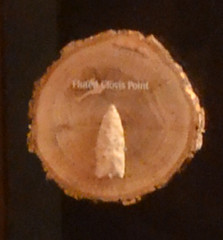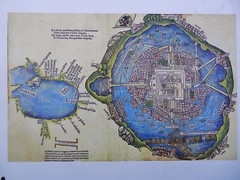![]()
![]()
![]()
Use LEFT and RIGHT arrow keys to navigate between flashcards;
Use UP and DOWN arrow keys to flip the card;
H to show hint;
A reads text to speech;
74 Cards in this Set
- Front
- Back
|
Clovis tip, pg. 5 |

The tip of a spear that has a jagged edge that made it cut better. Found in New Mexico |
|
|
Neolithic, pg. 5 |
Time period when humans used stones as weapons (spear, arrows). Means "new stone age" |
|
|
Incas, pg. 8 |
-Dominant in around 1400 CE -Capital Cuzco -2000 mile empire -No written language -They had high-altitude runners -invented the decimal system -Quipu- knott string in a certian way to communicate 1500 -they ruled 8-12 million people |
|
|
Olmecs, pg. 8 |
-First urban culture in mesoamerica -Created the giant stone heads -First pyramids -Ball parks -Created a written language -Created a dual calendar system -They believe in human sacrifice -In the empire of Teotihucan -Now modern day Mexico City -Sudden destruction in the mid-8th century |
|
|
Mayan, pg. 8 |
-Biggest city is Tikal -Closer to the carribiean -Astronamy- writting sytems- time keeping- blood letting (to speak to gods) -Weakened after the fall of Teotihuacan -Decayed in the 9th and 10th centuries -Drought |
|
|
Azetecs, pg. 10 |
-1400 Aztec power in the Valley of Mexico
-Tenochtitlán- on the lake Texcoco -Had the causeways- chinampas(floating gardens) -Built the great pyramid of the sun -Constatly at War -Didn’t want to take the people/ they wanted to use their supplies -Believed in a lot of human sacrifce/ on a giant scale -1519- many Indians in Mesoamerica would help the Spainards bring down the Aztecs
|
|
|
Tenochtitlán, pg. 10 |

Aztec city on the lake
|
|
|
Anasazi, pg.12 |
-Cliff-dwelling people
-Most information comes from Chaco Cayon in New Mexico and at Mesa Verde in Colorado -Lived apartment house that were 5 stories high--Craved into the cliffs -Built rodes -Left cites either because of drought or invaders |
|
|
Cahokia, pg. 13 |
-City near modern St. Louis
-flourished from 900-1200 CE |
|
|
Staple crop, pg. 18 |
-Something you need to survive
-ex. wheat, beans, etc. |
|
|
Slave labor, pg. 18 |
Using people to farm your land and work for you
|
|
|
Caravel, pg. 19 |
-New ship created by the Portuguese
-Best ship of it's time -could mount cannons on it |
|
|
Factories, pg. 19 |
small posts on the coast of Africa that would give them rest in the middle of a voyage
|
|
|
Atlantic slave trade pg. 19 |
-Portuguese start the slave trade
-would buy slaves from other africans in enemy tribes |
|
|
Santa María, pg. 22 |
|
|
|
Conquistadores, pg. 23 |
|
|
|
Hernán Cortés, pg. 25 |
|
|
|
Matrilineal, pg. 26 |
|
|
|
Encomienda, pg. 28 |
|
|
|
Hacienda, pg. 30 |
|
|
|
Serfdom, pg. 31 |
|
|
|
Columbian exchange, pg. 33 |
|
|
|
Predestination, pg. 38 |
|
|
|
Huguenots, pg. 39 |
|
|
|
Pedro Menéndez de Avilés, pg. 39 |
|
|
|
Coureurs de bois, pg. 40 |
|
|
|
Mourning wars, pg. 41 |
|
|
|
Intendant, pg. 41 |
|
|
|
Patroonship, pg. 44 |
|
|
|
Yankees, pg. 44 |
|
|
|
Non-Separatists, pg. 45 |
|
|
|
Separatists, pg. 45 |
|
|
|
privateer, pg. 46 |
|
|
|
Joint-stock company, pg. 47 |
|
|
|
Tsenacommacah, pg. 47 |
|
|
|
Fall line, pg. 47 |
|
|
|
House of Burgesses, pg. 48 |
|
|
|
Headright, pg. 48 |
|
|
|
Proprietary colonies, pg. 49 |
|
|
|
Sachem, PG. 54 |
|
|
|
Anne Hutchinson, pg. 56 |
|
|
|
Public Friends, pg. 63 |
|
|
|
Quitrent, pg. 65 |
|
|
|
Praying Indians, pg.74 |
|
|
|
Iroquois League, pg. 77 |
|
|
|
Convenant Chain of Peace, pg. 77 |
|
|
|
Onontio, pg. 79 |
|
|
|
Mercantilism, pg. 82 |
|
|
|
Balance of trade, pg. 82 |
|
|
|
Enumerated Commodities, p. 82 |
|
|
|
Whigs, pg. 83 |
|
|
|
Tories, pg. 83 |
|
|
|
Funded national debt, pg. 87 |
|
|
|
Entail, pg. 90 |
|
|
|
Primogeniture, pg. 90 |
|
|
|
Anglicization, pg. 100 |
|
|
|
Dowry, pg. 101 |
|
|
|
Coverture, pg. 101 |
|
|
|
Dower rights, pg. 101 |
|
|
|
Middle Passage, pg. 102 |
|
|
|
Gang System, pg. 102 |
|
|
|
Sickle cell, pg. 102 |
|
|
|
Task system, pg. 103 |
|
|
|
Gullah, pg. 104 |
|
|
|
Redemptioners, pg. 104 |
|
|
|
Fiat money, pg. 105 |
|
|
|
John Peter Zenger, pg. 106 |
|
|
|
Enlightenment, pg. 106 |
|
|
|
Consumer society, pg. 108 |
|
|
|
Evangelical, pg. 110 |
|
|
|
Presbytery, pg. 110 |
|
|
|
Synod, pg. 110 |
|
|
|
Revival, pg. 111 |
|
|
|
Freemasons, pg.112 |
|

